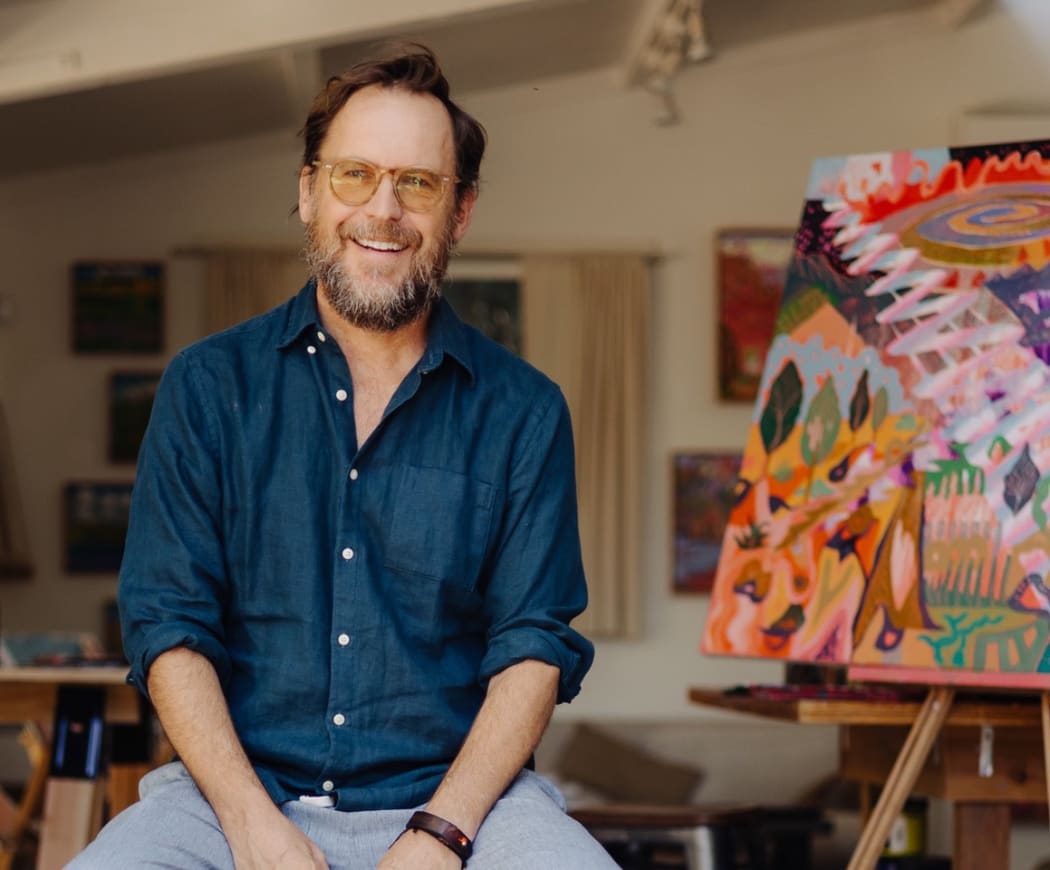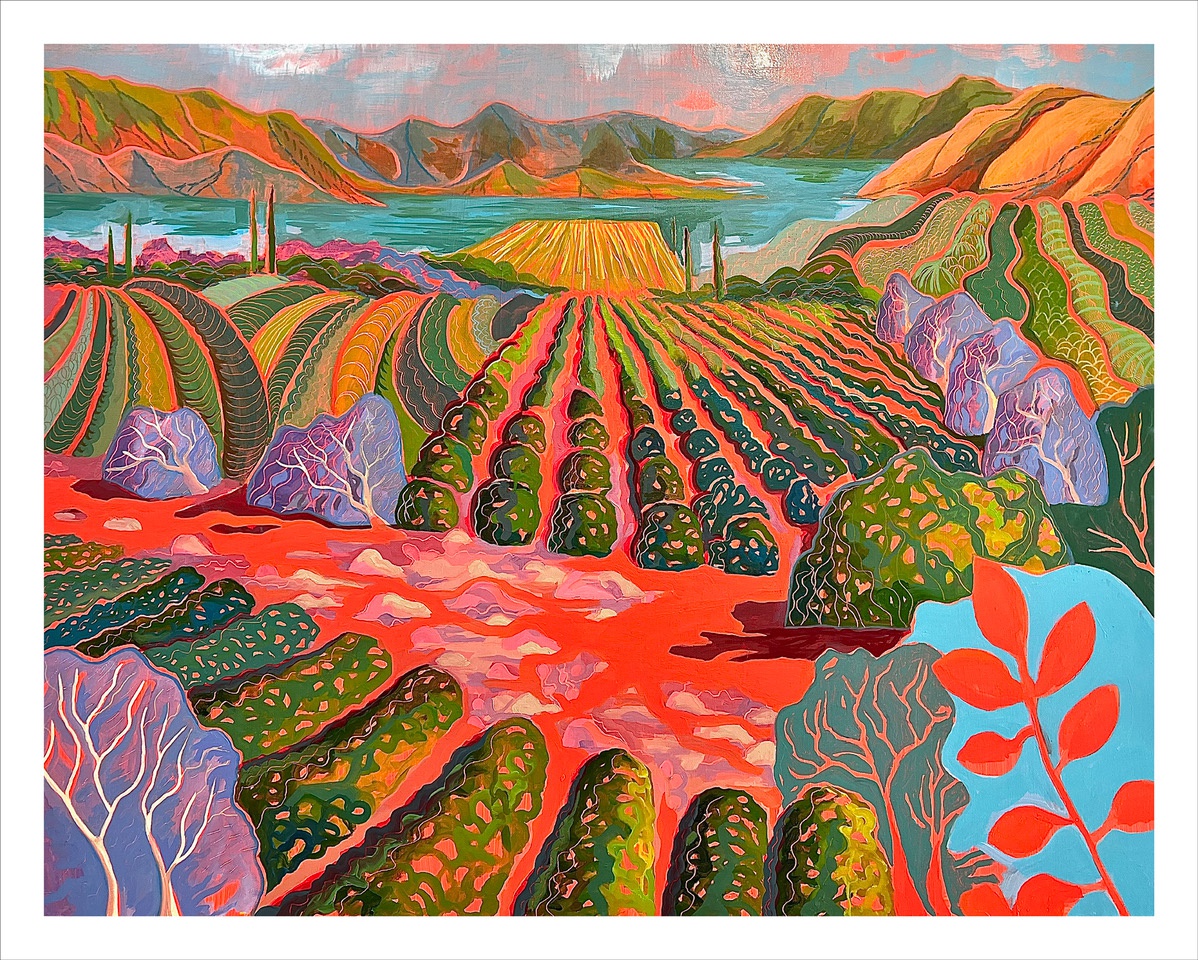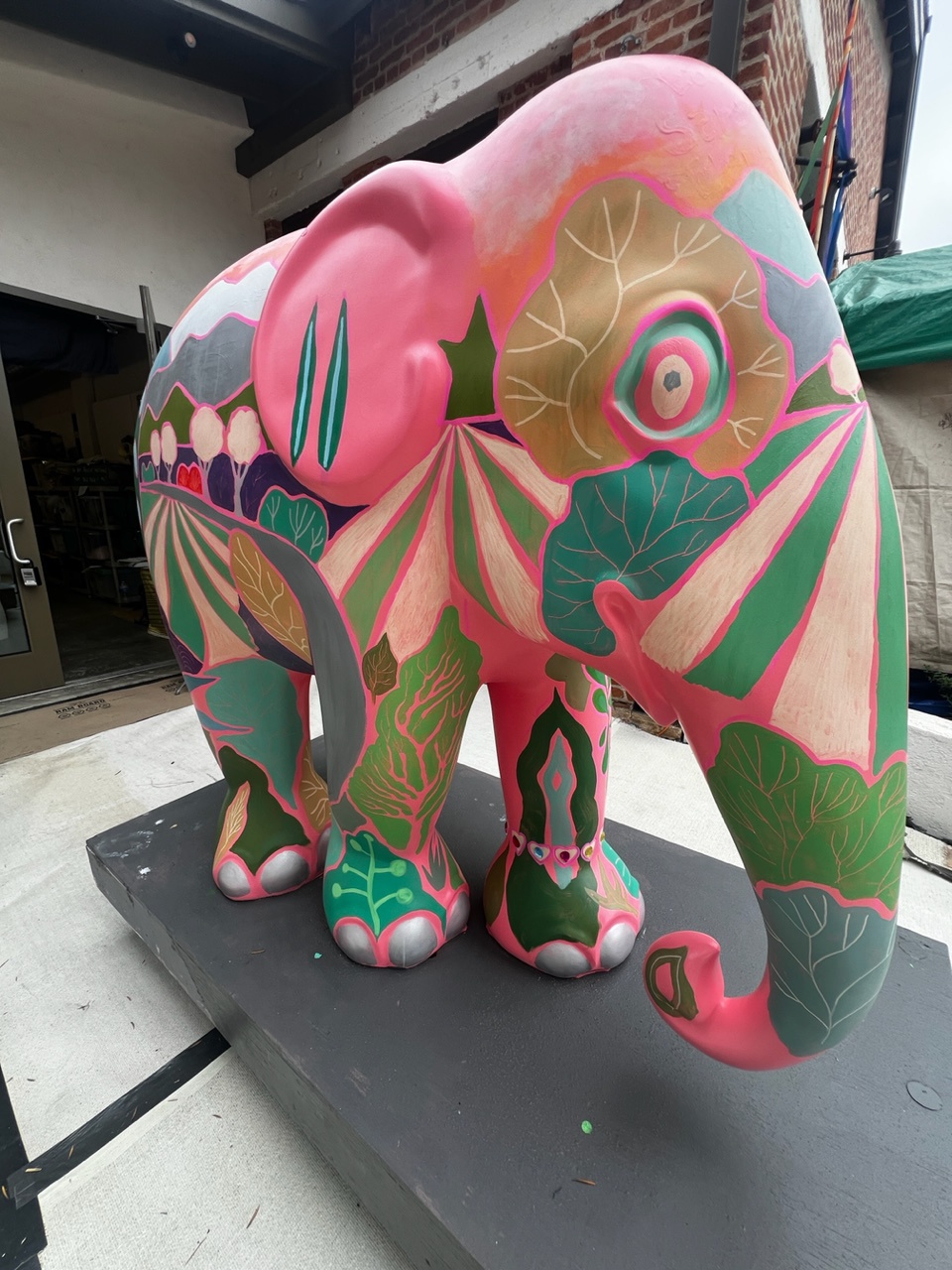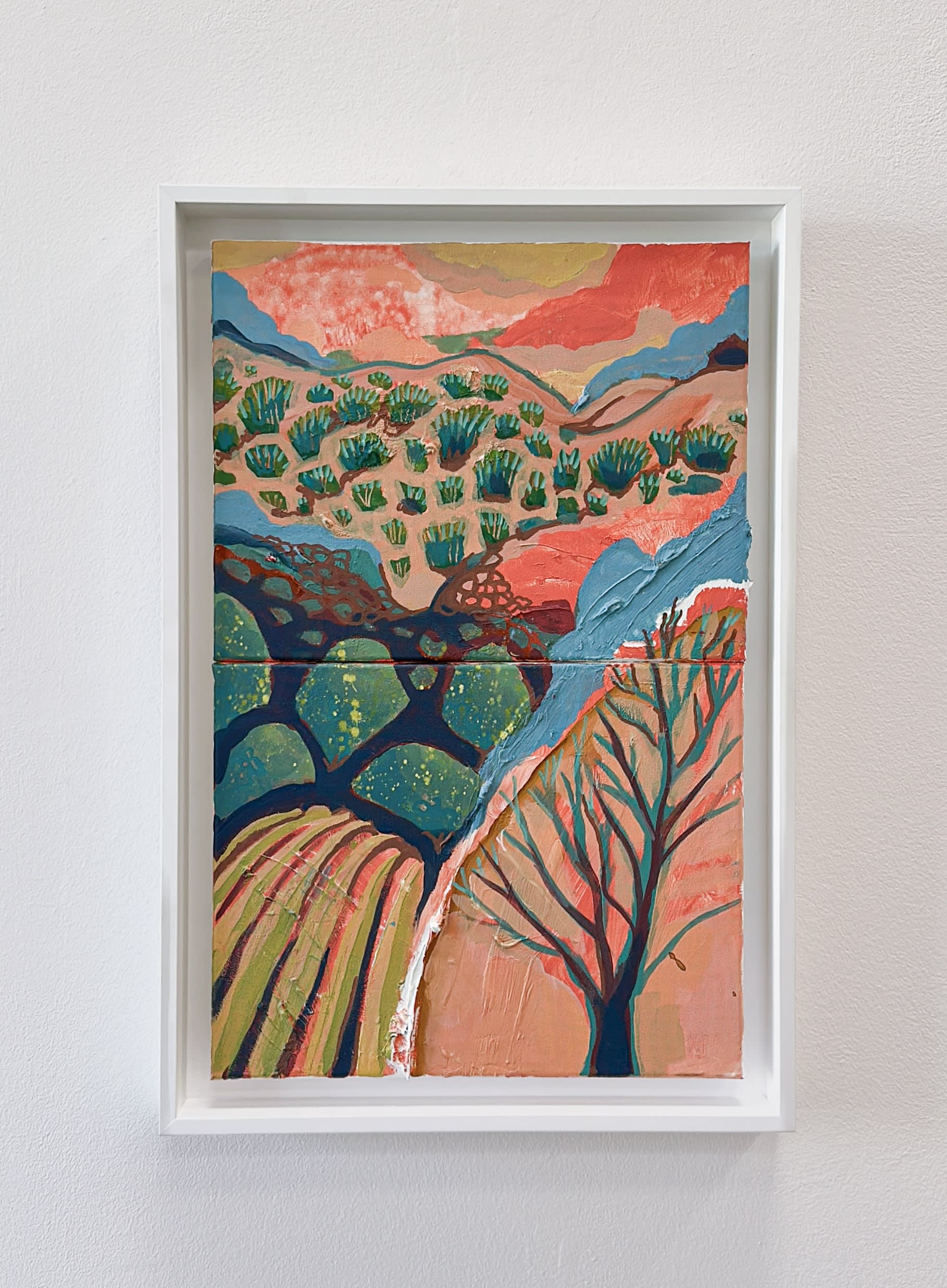
We recently interviewed Ojai, CA based artist, Christopher Noxon: a self-taught maker of paintings, murals, nesting dolls, illustrated journals and other things. A onetime journalist and author, Noxon is the author and illustrator of Good Trouble: Lessons from the Civil Rights Playbook, published by Abrams, as well as other books and published stories. His work is currently on view at Abigail Ogilvy Gallery, Los Angeles in "Game Time" through August 2, 2025:
Abigail Ogilvy Gallery: How did you become an artist?
Christopher Noxon: I came to painting in midlife, after a move from LA to Ojai and a string of seismic personal losses, including the sudden death of my eldest son. I started painting not as a grand pivot or career move, but as a way to keep from falling apart. I got to work in a studio in a grove of olive trees, with no formal training and no real plan. I paint to get lost, to connect with something beyond words or this world. In making work I connect with the “this is it” feeling my painter grandmother Betty Lane wrote about in her diaries. I make pictures to get at the “thing behind the thing,” to look behind the veil of the seen, to chase a simultaneous feeling of awe and humility, of togetherness and singularity, of personal insignificance and limitless possibility. I still don’t know if this makes me a capital-A “artist” – I don’t think of art as an identity but as a VERB that works on and through me.
AOG: How do you hope viewers will interpret your work? What feelings do you hope they experience?
CN: Honestly, I’m less interested in how people decode or interpret my work than in how they feel it. I hope they feel some version of what I do when I look at my favorite pictures, a mixture of wonder and bafflement and delight.
When people visit my studio, nine times out of ten they’ll pause and say some version of: “Wow… so much.” Then they’ll either scrunch up their face and make a quick exit or start wandering around letting the pictures do what they do for me. I love the feeling of super-saturation and world-building, the dreamy calm I felt as a kid drawing imaginary maps or the engrossed concentration I felt clicking together whole cities with Legos with my kids when they were little.
AOG: What does your artistic process look like? Do you paint your landscapes on site, or in your studio?
CN: I gather material outside—walks, hikes, notes, photos, sketches—but the real action happens in the studio. That’s where I do experiments and make messes and get my hands dirty. The studio is packed floor-to-ceiling with supplies, journals, art books, old postcards, scraps of ephemera, and even a collection of toy chickens. It’s a maximalist’s playground. In making a new painting I often start with a thumbnail sketch and vague idea of the end result, but once I get going, the picture takes over. I layer, scrape, repaint, let the picture tell me what it wants. Most of the time I don’t “know” what I’m doing, which is how I know something interesting might happen.

Christopher Noxon, “Awah’y 2,” Mixed media on canvas, 2023
AOG: What role does color play in your artwork? Are you drawn to specific palettes?
CN: I use color intuitively and excitedly and without regard to rules of hue, value, saturation or restraint. I’ve tried (and failed) to keep my work muted and tasteful — a recurring note in my studio journal: “SIMPLIFY GODDAMNIT” — but once I get going I always seem to veer into the maximal and wildly chromatic. I love how colors clash, buzz, glow, fight and sing. I typically start a picture with a coat of what I call “ground pink” - a mix of titanium white, cadmium red, yellow oxide and florescent pink. It’s less the color of Barbie’s dream house or a wad of bubblegum than a fresh-cut grapefruit or twilight on a mountain. I love this color as a base - it feels like a force field, like the energy behind everything, like the fleshy-warm place we all came from and are all headed.
AOG: What drew you to painting? Have you explored other media?
CN: In my past life, I wrote for publications including the New Yorker, the Atlantic and the New York Times. I wrote and illustrated the book Good Trouble: Lessons from the Civil Rights Playbook, the novel Plus One and the nonfiction Rejuvenile: Kickball, Cartoons Cupcakes and the Reinvention of the American Grown-Up. Last year I illustrated the book Can We Talk About Israel?: A Guide for the Curious, Confused and Conflicted.
As a writer I’d always doodled and kept visual journals. The artwork in these books got progressively more elaborate, and I began painting full time after moving to Ojai in 2020. Unlike writing, which has always been intensely effortful and interior to me (I work hard to sound like myself) painting feels playful and expansive (I don’t know who’s responsible for the finished work). Recently I’ve done two big mural projects, experimented with printmaking and just completed a project for a nonprofit in which I painted a landscape on a lifesize baby elephant!

Christopher Noxon's painted elephant. A part of Elephant Parade® Official
AOG: How has your writing career influenced your art?
CN: Writing taught me about structure, editing, revision and how much deep thought and hard work goes into something that reads as elegant and effortless. Painting is an entirely different process – it’s beyond thought, beside the point of effort. I write to discover what I think; I make pictures to lose myself. As I get older I’m less and less interested in who I am than who I’m not.
AOG: Do you have a favorite place to paint?
CN: The Ojai Valley is my starting place and anchor. The landscapes here are wild and alive and full of contradictions—rolling, scratchy, lush, dry, sacred, ordinary. The hills, the skies, the clusters of cacti and succulents and cloudbursts… it’s all charged with a low hum of energy. The vortex is real. I’ve also done paintings on location in Prospect Park in Brooklyn, the Civita di Bagnoregio in Central Italy and most recently, the High Sierras in Northern California - I work from memory, dreams, photos, hikes, walks. But the studio is where the translation happens—where the pictures reveal what they want to be.
AOG: You’ve stated that Betty Lane is your favorite artist. How are you related and has she influenced your work?
CN: Betty was my dad’s mother, and she shaped my idea of what it meant to be an artist long before I started making work of my own. She lived alone in a little A-frame on Cape Cod filled with odd treasures—a spinning pterodactyl, chunks of mosaic and thousands of paintings. She worked all the time, often filling both sides of a panel, and wore necklaces made of eucalyptus pods. She once framed a “busy picture” I drew as a kid—a chaotic mix of mountains, bushes, and skyscrapers—and hung it alongside her own work. It was the only time she explicitly encouraged me, and it meant everything.
She had some success as a painter – a piece of hers was acquired by the Metropolitan Museum in NY and she’s continued to sell with Sullivan Goss gallery in Santa Barbara – but her real value to me has been as a teacher. Shortly after moving to Ojai, I came into possession of more than 300 of her artworks along with writings and records and sketchbooks. I studied her compositions, revisited her diaries, emulated the way she captured light and place. Her spirit is everywhere in my studio. She wasn’t big on categorization—surreal, modern, expressionist—all that bored her. What she cared about was experience. “I am no intellectual and no genius,” she once wrote, “but I am capable of experience.” That’s what she passed down, and what I try to honor.

AOG: What do you enjoy doing for fun outside of your practice?
CN: I cook. I read. I camp. I go see live music (favorite recent shows: Cat Power does Dylan, Big Thief at Hollywood Forever, Dan Reeder in Santa Barbara). I take walks with my dog, a neurotic goldendoodle named Yogurt. I teach art classes at a local social service agency and help out on the boards of the Ojai Valley Museum and the Ojai Studio Artists. I make altars with found objects and decorate nesting dolls.
AOG: What advice do you have for artists just starting out?
CN: Who cares whether you’re an “artist” - just make something. Then make something else. Get out of the way. Let the thing tell you what it wants. Don’t worry too much about whether what you make is “good” - the most interesting stuff happens beyond good and bad. Sister Corita was right: it’s all an experiment (Also, essentially: “find a place you trust and then try trusting it for awhile” - meaning create/find/set aside a dedicated space for your practice - having a studio changed EVERYTHING for me, but before that I did all my work in journals which was fun too!). Find a community - talk with others making work and get into a scene. Nothing is made in a vacuum. Most importantly, keep coming back to the work itself - it’s the best teacher. And if you’re not sure what something means—ask: how does it make you feel?
Visit Christopher Noxon's instagram account.
Blog by Emma Lenning

Add a comment